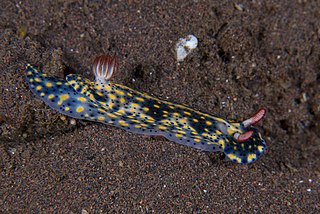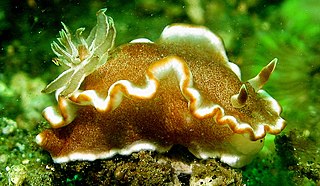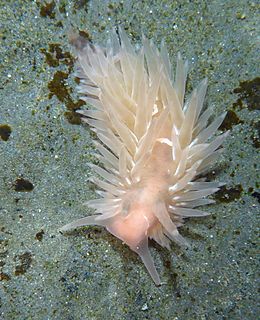
The Portuguese man o' war, also known as the man-of-war, blue bottle, or floating terror is a marine hydrozoan found in the Atlantic, Indian and Pacific Oceans. Physalia is the only genus in the family Physaliidae, Physalia is monospecific with Physalia physalis as the only species in the genus. Long tentacles have numerous venomous microscopic nematocysts which deliver a painful sting powerful enough to kill fish and even occasionally humans. Despite its appearance, the Portuguese man o' war differs from single organisms like jellyfish as they are siphonophores, a colonial organism made up of many specialized, though genetically distinct, parts called zooids. These zooids are attached to one another and are physiologically integrated to such an extent that they cannot survive independently. The assemblage of zooids works together to function as an individual animal. Zooids should not be confused with zooplankton.

The gastropods, commonly known as snails and slugs, belong to a large taxonomic class of invertebrates within the phylum Mollusca called Gastropoda. This class comprises snails and slugs from saltwater, from freshwater, and from the land. There are many thousands of species of sea snails and slugs, as well as freshwater snails, freshwater limpets, and land snails and slugs.

Sea cucumbers are echinoderms from the class Holothuroidea. They are marine animals with a leathery skin and an elongated body containing a single, branched gonad. Sea cucumbers are found on the sea floor worldwide. The number of holothurian species worldwide is about 1,717 with the greatest number being in the Asia Pacific region. Many of these are gathered for human consumption and some species are cultivated in aquaculture systems. The harvested product is variously referred to as trepang, namako, bêche-de-mer or balate. Sea cucumbers serve a useful role in the marine ecosystem as they help recycle nutrients, breaking down detritus and other organic matter after which bacteria can continue the degradation process.

Nudibranchs are a group of soft-bodied, marine gastropod molluscs which shed their shells after their larval stage. They are noted for their often extraordinary colours and striking forms, and they have been given colourful nicknames to match, such as "clown," "marigold," "splendid," "dancer," "dragon," or "sea rabbit." Currently, about 3,000 valid species of nudibranchs are known.

Glaucus atlanticus is a species of small, blue sea slug, a pelagic aeolid nudibranch, a shell-less gastropod mollusk in the family Glaucidae.

Marine ecosystems are the largest of Earth's aquatic ecosystems and are distinguished by waters that have a high salt content. These systems contrast with freshwater ecosystems, which have a lower salt content. Marine waters cover more than 70% of the surface of the Earth and account for more than 97% of Earth's water supply and 90% of habitable space on Earth. Marine ecosystems include nearshore systems, such as the salt marshes, mudflats, seagrass meadows, mangroves, rocky intertidal systems and coral reefs. They also extend outwards from the coast to include offshore systems, such as the surface ocean, pelagic ocean waters, the deep sea, oceanic hydrothermal vents, and the sea floor. Marine ecosystems are characterized by the biological community of organisms that they are associated with and their physical environment.

Aeolidiidae, a family of aeolid nudibranchs, are a family of sea slugs, shell-less marine gastropod molluscs.

The Caspian Sea is the world's largest inland body of water, variously classed as the world's largest lake or a full-fledged sea. It is an endorheic basin located between Europe and Asia, to the east of the Caucasus Mountains and to the west of the broad steppe of Central Asia. The sea has a surface area of 371,000 km2 and a volume of 78,200 km3. It has a salinity of approximately 1.2%, about a third of the salinity of most seawater. It is bounded by Kazakhstan to the northeast, Russia to the northwest, Azerbaijan to the west, Iran to the south, and Turkmenistan to the southeast. The Caspian Sea is home to a wide range of species and may be best known for its caviar and oil industries. Pollution from the oil industry and dams on rivers draining into the Caspian Sea have had negative effects on the organisms living in the sea.

Hypselodoris infucata is a species of colourful sea slug or dorid nudibranch, a marine gastropod mollusk in the family Chromodorididae.

Glossodoris rufomarginata, commonly called white-margin sea slug or caramel nudibranch, is a species of colourful sea slug, a dorid nudibranch, a marine gastropod mollusc in the family Chromodorididae.

Hypselodoris pulchella is a species of sea slug, a dorid nudibranch, a marine gastropod mollusk in the family Chromodorididae.

Hypselodoris maridadilus is a species of colourful sea slug or dorid nudibranch, a marine gastropod mollusk in the family Chromodorididae. It feeds on sponges.

Hypselodoris kaname is a species of sea slug or dorid nudibranch, a marine gastropod mollusk in the family Chromodorididae.
Hypselodoris jacksoni is a species of colourful sea slug or dorid nudibranch, a marine gastropod mollusk in the family Chromodorididae.

Aeolidiella alderi is a species of sea slug, an aeolid nudibranch in the family Aeolidiidae. It is native to northwestern Europe where it occurs in the intertidal zone. It is a predator and feeds on sea anemones.

Aeolidia loui is a species of sea slugs, an aeolid nudibranch, a marine gastropod mollusc in the family Aeolidiidae. It has been regarded as the same species as the NE Atlantic Aeolidia papillosa but is now known to be a distinct species. Common names include shaggy mouse nudibranch, and shag-rug nudibranch.

Aeolidia filomenae is a species of sea slugs, an aeolid nudibranch, a marine gastropod mollusc in the family Aeolidiidae. Previously confused with Aeolidia papillosa, this species occurs on coasts of the NE Atlantic Ocean from Scotland south to Portugal.
Ziminella vrijenhoeki, is a species of sea slug, in the family Paracoryphellidae. It was discovered at Monterey Canyon by MBARI researchers near a whale carcass 1000 meters below the surface, and was named after Robert Vrijenhoek, a MBARI evolutionary biologist. It is bright orange, and grows about 20 millimeters long.
Cuthona methana is a species of sea slug in the family Tergipedidae. It is small, only 4 to 6 millimeters in length, with long gills. C. methana was discovered at a seafloor at Hydrate Ridge, with layers of methane hydrate which is a mixture of seawater and methane. It was named C. methana for it being discovered near methane bubbling out of the sea floor, giving the species name methana.
Dendronotus claguei is a species of sea slug in the family Dendronotidae. It was discovered by the MBARI while exploring the Alarcón Rise, found on an inactive hydrothermal chimney. The scientists collected two specimens, one 7 mm in length and the other 18 mm in length. Their discovery raised questions on how nudibranchs were surviving 2,370 m below the surface, living in a low food environment where very few other animals could be found.















